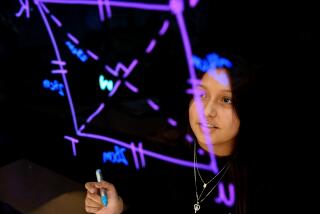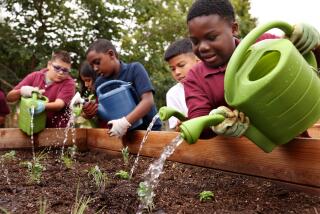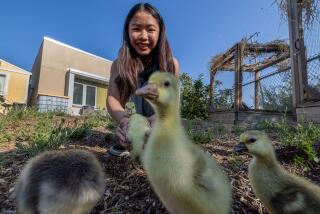Results Positive for Science Unit
SAN FRANCISCO — Bertha Medina was determined to make her fan work. First she checked the motor. Then she spotted the problem. After a quick snip of a flower pasted too close to the blades, she smiled as fresh air blew on her face.
Her science project was up and running.
The 9-year-old is one of many students who gather after school in San Francisco’s largely Latino Mission District to experiment with physics, chemistry, biology and engineering. The free program started 10 years ago in a San Francisco garage and will soon go nationwide thanks to a $3-million grant from the National Science Foundation.
“It broadens their worlds,” said founder Dan Sudran, 57. “I always tell them, ‘Whether you end up working in science or not, it just makes you see life in a bigger picture.’ ”
Simplifying Tools of the Trade
The students at the lab don’t wear goggles, aprons or gloves.
Their projects include modeling bones out of clay and caring for reptiles and fish. Finished and unfinished projects litter the space, while motors and batteries decorate the walls.
“My friend told me she came here and she told me it was great, so I decided to come and see if I liked it, and I do,” said Xiomara Beltran, 10.
With help from San Francisco State University, the programs now operate at 10 sites in Los Angeles, Fresno, Oakland, San Jose and Watsonville.
Last year, Paul Fonteyn, vice president of the university’s Office of Research and Sponsored Programs, helped the program grab the interest of the Smithsonian Institution.
Fonteyn later co-authored a grant request, and is looking forward to the program expanding to 15 sites nationwide, including Miami, Houston, New Orleans, Detroit, Seattle and New York.
In Washington, D.C., Mario Castellanos of the Smithsonian will use the San Francisco model to begin a workshop at the Latin America Youth Center. Castellanos said the best part of the program is that it allows students to get their hands on projects without having to memorize theories first.
According to a Department of Education survey in 1998, the most recent figures available, about 15% of minority students--blacks, Latinos and American Indians--received scientific degrees.
San Francisco State biology professor Leticia Marquez-Magana said she hopes such after-school programs will encourage more women, who traditionally have shied away from science, to be drawn to science-and engineering-related careers.
Setting a Good Example
“The best thing is that they provide appropriate role models since the founders are minority scientists themselves,” she said.
But science aside, just ask anyone at the after-school program in the Mission District, and they’ll tell you it’s fun.
Xiomara’s favorite project was a Halloween mask. It included partnering up and smearing petroleum jelly all over each other’s faces. Strips of wet bandages were then added.
“You have to sit still for a couple of minutes, and you feel it harden on your face,” she said. “The best part was that you got to paint it.”
More to Read
Sign up for Essential California
The most important California stories and recommendations in your inbox every morning.
You may occasionally receive promotional content from the Los Angeles Times.










